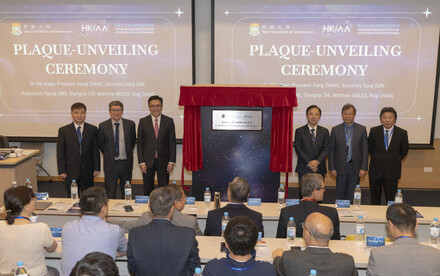05 Sep 2024
First Thickness-Dependent Transitions in 2-dimensional Magnetic Material

From the left: Dr Chengkang ZHOU and Professor Zi Yang MENG from the Department of Physics at The University of Hong Kong.
A team of physicists from The University of Hong Kong (HKU), Texas Tech University (TTH), and the University of Michigan (UMich), has made an important discovery in the study of van der Waals (vdW) magnetic materials, a special class of materials with unique electronic and magnetic properties that make them attractive for use in various applications.
Their research is the first to experimentally observe a transition in Nickel Phosphorus Trisulfide (NiPS3), a type of van der Waals material that has been studied for its potential applications in electronic devices and energy storage, from a 3-dimensional (3D) long-range order state to a 2-dimensional (2D) flat pattern vestigial order state. They have shown how the material changes its magnetic properties as it becomes thinner, revealing new insights into how this material can be used. This research is significant because it helps us understand how to control the magnetic properties of materials at very small scales, which could lead to advancements in technology, such as more efficient electronics, high-density data storage, and innovative computing devices that consume less energy. Their findings have just been published in Nature Physics and featured in ‘News and Views’, highlighting its significance and implications for the field.
Unravelling Feynman’s Legacy: Spotlighting Layered Materials
‘What could we do with layered structures with just the right layers?’ Richard Feynman, the Nobel Prize winner in Physics in 1965, posted this intriguing question in his famous 1959 lecture, ‘Plenty of Room at the Bottom’. This statement did not receive much attention at the time, but it was revisited in the 1990s, as it was fundamentally related to the foundations of nanotechnology.
In recent years, the emergence of van der Waals materials, such as NiPS3, has provided exciting opportunities for exploration of Feynman’s question. These materials consist of layers that can be easily stacked or separated, enabling researchers to investigate their properties at varying thicknesses. To address Feynman’s question, the research team turned their attention to NiPS3, which exhibits fascinating magnetic behaviour when reduced to just a few layers or even a single layer. This unique property makes NiPS3 an ideal candidate for studying how its magnetic characteristics evolve as its thickness changes.
In condensed matter physics, one of the key ways to study materials is to understand how they transition between different phases or states as their properties, like temperature or thickness change. These transitions often involve changes in the material’s symmetry, a concept known as symmetry breaking. In the case of NiPS3, the researchers observed an intermediate symmetry breaking which leads to a vestigial order. Just as the term ‘vestigial’ refers to the retention of certain traits during the process of evolution, the vestigial order here can also be viewed as the retention during the process of symmetry breaking. This happens when the primary magnetic long-range order state melts or breaks down into a simpler form, in the NiPS3 case, a 2D vestigial order state (known as Z3 Potts-nematicity), as the material is thinned. Unlike conventional symmetry breaking, which involves the breaking of all symmetries, vestigial order only involves the breaking of some symmetries. While there are numerous examples from a theoretical standpoint, experimental realisations of vestigial order have remained challenging. However, the investigation of this 2D magnetic material has shed the first light on this issue, demonstrating that such a phenomenon can be observed through dimension crossover.
When Theory and Computation Meets Experiments
To capture the emergence of the vestigial order, the research team studied NiPS3 and utilised nitrogen-vacancy (NV) spin relaxometry and optical Raman quasi-elastic scattering to characterise the melting process in the primary order and the emergence of the vestigial order as the thickness changed (see Figure 2). In order to better understand the experimental findings of the dimensional crossover in NiPS3, the team also performed large-scale Monte Carlo simulations to visualise the magnetic phase for bilayer NiPS3 (see Figure 3). This work is the first to track two distinct symmetries as a function of dimensionality carefully, and hence to discover the crossover from the primary order to the vestigial order. And the large-scale Monte Carlo simulation discovers the vestigial phase transition in this crossover process.
The research team's observations not only deepen our understanding of the differences between 2D and 3D physics but also bring us one step closer to answering the question posed by Feynman 65 years ago. Looking ahead, the investigation of layered materials, such as multilayered graphene and NiPS3, holds great promise for developing a wide range of planar electronic devices. These materials offer the potential for high performance, low power consumption, and desirable properties like flexibility and transparency, which present an attractive pathway towards the creation of ultradense, low-power, flexible 2D logic and memory circuits. With this advancement, we are inching closer to the realization of Feynman's vision of layered materials and devices with precisely engineered layers.
About the Research Team
The research team is comprised of physicists, including Dr Chengkang ZHOU and Professor Zi Yang MENG from the Department of Physics at The University of Hong Kong, along with their collaborators Professor Rui HE from the Department of Electrical and Computer Engineering at Texas Tech University, as well as Professors Liuyan ZHAO, Kai SUN and Dr Zeliang SUN from the Department of Physics at the University of Michigan.
About the Journal Paper
‘Dimensionality crossover to 2D vestigial nematicity from 3D zigzag antiferromagnetism in an XY-type honeycomb van der Waals magnet’, Zeliang Sun, Gaihua Ye, Chengkang Zhou, Mengqi Huang, Nan Huang, Xilong Xu, Qiuyang Li, Guoxin Zheng , Zhipeng Ye, Cynthia Nnokwe, Lu Li, Hui Deng, Li Yang, David Mandrus, Zi Yang Meng, Kai Sun, Chunhui Du, Rui He, Liuyan Zhao. Nature Physics, 2024
The journal paper can be accessed here.

Thickness dependence of signatures in optical Raman quasi-elastic scattering. a, thickness v.s. temperature phase diagram of NiPS3. b, Layer-dependent Raman spectra at T=10 K. c, linearly lairized Raman spectra measured with λ=633 nm at 10 K on bulk NiPS3. The blue (d) and red (e) areas denote the mode and
mode, respectively. (Image adapted from respective paper)

Monte Carlo calculations of the magnetic state in 2L . a, Temperature dependence of the scaled Potts-nematic order parameter (
). Inset: Zoom-in around nematic phase transition temperature
,
. b, Correlation of Potts-nematicity (
) and spin (
) at a temperature
,2L, as a function of distance. c, Snapshot of simulated spin configuration below
, 2L. d, Image of simulated nematic director for the spin state in c, showing homogeneity of nematicity. (Image adapted from respective paper)






